So now we know. Wings trump sails. Theory has always stated that a wing rig should be faster than conventional sails. But the challenge was actually to put a wing rig into practice, to be able to build it in less than six months, and also to manage the logistics of it.
Alinghi acknowledged that they had been outgunned by superior technology, although the margin of defeat must still have come as a big shock. They weren’t even in the same ball park. James Spithill generously pointed out that if the match had taken place in Ras Al Khaimah as Alinghi had expected, then the contest might have been much closer. Alinghi 5 drew her design inspiration from Alinghi 41, Bertarelli’s 10-year-old catamaran which he sails on Lake Geneva. In the light tears and flat water of Ras Al Khaimah, the Swiss may well have posed a much bigger challenge to the Americans. But in the changeable breezes and lumpy waves off the coast of Valencia, the boat looked unbalanced and difficult to sail.
Spithill, steering the giant trimaran from his lofty perch on the back beam of USA-17, said that the wing had transformed the way they sailed the boat. “Our coach Glenn Ashby had always been telling us to aim for less steering and more trimming, and that’s what the wing enabled us to do,” he said. The difference in sailing style between the two boats was night and day. Whether it was Bertarelli or Peyron steering Alinghi 5, it took a lot of wheel work to keep the windward hull flying. On the other hand, once Spithill had done his pre-start manoeuvring magic, out on the open course he just had to hold the wheel steady while the easily adjusted electronically and hydraulically-operated two-element wing did all the work.
No doubt Spithill made it look much easier than it actually was. He was already one of the best match racers in the world, and now it’s clear that he is one of the best multihull sailors in the world.
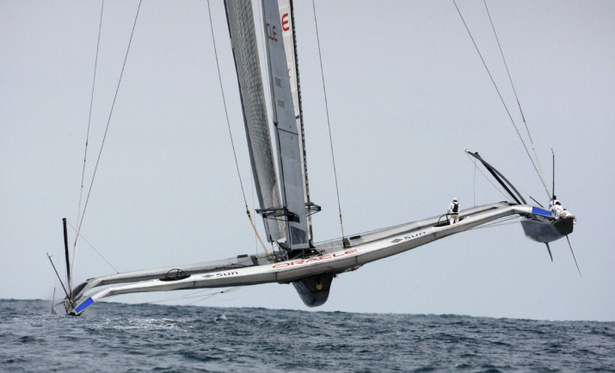
© Reuters / Dani Cardona
So to the 34th America’s Cup
We never did see a joint press conference with Bertarelli and Ellison sharing the same table, but as the Alinghi press conference drew to a close and the prizewinners’ conference was about to begin, we did see Bertarelli exchange handshakes with Ellison and his former skipper of Alinghi, Russell Coutts. It was an awkward moment, and no one really believes that they love each other any more now than they did before.
Will we see Alinghi return to the fray? That would depend on what type of America’s Cup BMW Oracle proposes, said Bertarelli.
Larry Ellison made a bold promise: “One thing I would like to assure people about the 34th America’s Cup. There will be a completely independent jury, there will be completely independent umpires. It will be an independent group which manages the next America’s Cup and there will be a level playing field for all competitors.”
The future direction of the America’s Cup now lies in Russell Coutts’s hands. It was over this very subject that Bertarelli and Coutts’s good friendship turned sour. Now it is up to the iconic sailor to prove that he is an equally good administrator of the sport. Along with Ellison, Coutts made an unprecedented promise to decide the future of the Cup on a democratic, consultative basis.
“We don’t want to make a protocol that might not work for the majority of competitors,” he said. Topics for debate that he is prepared to share with the challengers include re-introducing a nationality rule and what kind of boats people want. “Though I started pretty strong a few weeks ago on the idea of this returning to monohull competition, that racing was pretty spectacular and maybe we shouldn’t rule out the idea of a multihull,” he said.
The new Challenger of Record is an Italian team, Vincenzo Onorato’s Mascalzone Latino, representing the Club Nautico di Roma. It will be Onorato’s job to hold BMW Oracle to the high standards of governance that they have set for themselves. Perhaps now, after two and a half years of legal wrangling, the Cup is re-emerging into a brighter light again.
The 33rd America’s Cup didn’t feel like a proper America’s Cup. It was a low-key, ill-humoured affair fought in bitterly cold wintry conditions. But the racing was spectacular and the technology was breathtaking, particularly that 223-foot, majestic wing rig.

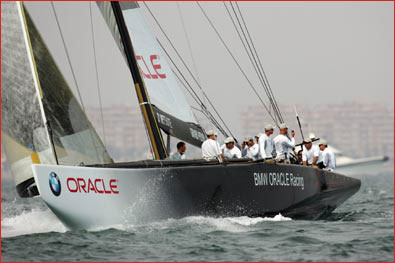 BMW Oracle has been carrying out some extensive TV trials of monohulls and multihulls in Valencia. The aim, says the Defender, is to work out which kind of boat is going to offer the biggest bang for buck in Russell Coutts’s vision of a more media-friendly and commercially-attractive America’s Cup...
BMW Oracle has been carrying out some extensive TV trials of monohulls and multihulls in Valencia. The aim, says the Defender, is to work out which kind of boat is going to offer the biggest bang for buck in Russell Coutts’s vision of a more media-friendly and commercially-attractive America’s Cup...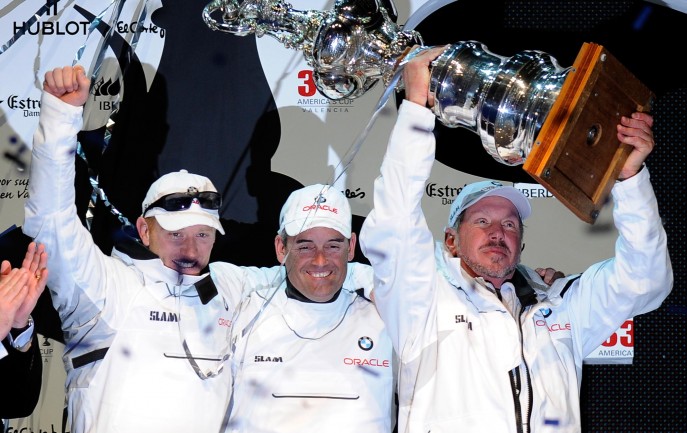 So now we’ve seen the power of wing rigs in action in the America’s Cup, what possibility of a trickledown of technology into other forms of sailing? What about superyachts? BMW Oracle’s design team director Mike Drummond observed, tongue in cheek: “If you go to Wings R Us.com, you can get any size you like.” Of course, this technology is anything but off the shelf, but nor is it new, as Drummond also pointed out: “Wings are not new, they’ve been used by birds for quite a long time...
So now we’ve seen the power of wing rigs in action in the America’s Cup, what possibility of a trickledown of technology into other forms of sailing? What about superyachts? BMW Oracle’s design team director Mike Drummond observed, tongue in cheek: “If you go to Wings R Us.com, you can get any size you like.” Of course, this technology is anything but off the shelf, but nor is it new, as Drummond also pointed out: “Wings are not new, they’ve been used by birds for quite a long time...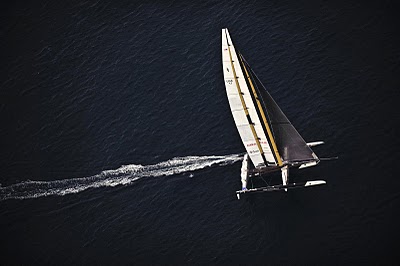 Race 2 was set to take place two days later on the Sunday. It was another long wait while Harold Bennett looked for suitable conditions in which to start the race. The cut-off time of 4pm was just minutes away when Bennett called for the start procedure to begin...
Race 2 was set to take place two days later on the Sunday. It was another long wait while Harold Bennett looked for suitable conditions in which to start the race. The cut-off time of 4pm was just minutes away when Bennett called for the start procedure to begin...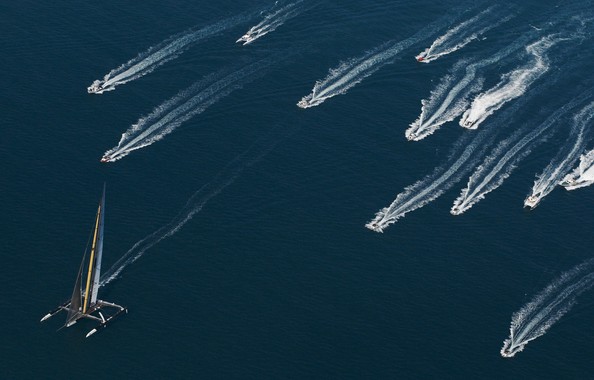 The wind was light and patchy that day, with Harold Bennett waiting for the breeze to settle. Alinghi clearly wanted to get on with it, flying a hull right past Bennett’s committee boat. BMW Oracle gave the impression of being rather more reluctant...
The wind was light and patchy that day, with Harold Bennett waiting for the breeze to settle. Alinghi clearly wanted to get on with it, flying a hull right past Bennett’s committee boat. BMW Oracle gave the impression of being rather more reluctant...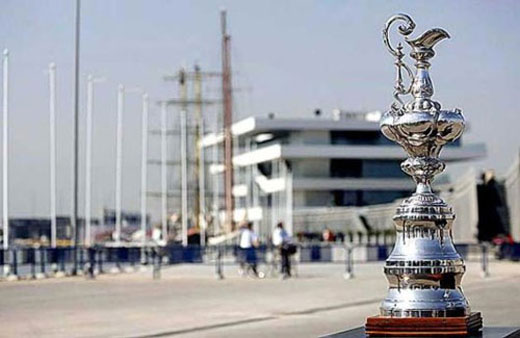 Guessing the outcome of an America’s Cup isn’t meant to be easy, but the majority of pundits seemed so taken by the revolutionary solid wing rig of BMW Oracle racing to do anything other than believe that the Americans would win...
Guessing the outcome of an America’s Cup isn’t meant to be easy, but the majority of pundits seemed so taken by the revolutionary solid wing rig of BMW Oracle racing to do anything other than believe that the Americans would win...